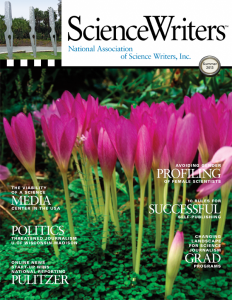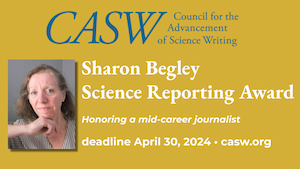Academic research relevant to the workaday world of science writing
By Rick Borchelt
Old chestnuts
This column marks my last as a regular contributor of Scholarly pursuits. As many of you know, the appetite for many federal agencies in supporting scholarly activity in science communication has never been particularly ravenous in the best of times. The current budget drought has meant that my office — like many others — is shortstaffed already and under a hiring freeze. So the departure of my co-author and collaborator Ben Carollo from my staff, announced last issue, makes it especially difficult to keep the column going as a regular piece. I hope to be able to periodically share research findings online or on the NASW discussion boards as time and enthusiasm permit.
I thought I would use this last Scholarly Pursuits to share three seminal pieces of research from the dawn of history for most of you that I think every practitioner of science communication should know and be able to recite word for word. Well, not quite, but these three do — in my mind — inform the very foundation of our enterprise, and pose difficult challenges or questions that have not yet been addressed. Or, just as likely, have provided answers the community would just as soon ignore.
Carter, Roy E. Jr. 1958. Newspaper “gatekeepers” and the sources of news. Public Opinion Quarterly 22(2), pp. 133-144.
The first and oldest of the three is nearly as old as I am: Roy Carter’s 1958 paper on newspaper gatekeepers and news sources. It wasn’t the first paper on the issue; Paul Lazarsfeld and Robert Merton had begun to plow the field of interactions between press and sources in Wilbur Schramm’s opus Mass Communications, and others had used the term “gatekeepers” in relation to how different media actors controlled the flow of news. Carter, though, began to postulate broader theories about how these interactions take place, and on the variables that affect how satisfied reporters and sources were with those interactions. Carter treats two studies he has done in the 1958 paper, an analysis of press-physician relationships in his (then) home state of North Carolina, and a similar study of press interactions with school administrators in California.
In language that would be topical in a graduate seminar today, Carter identifies a critical element of the press-medical relationship: status conferral. For both the physicians and the school administrators, positive interactions with the press depended on the sources’ belief that being quoted in the newspaper was a net gain; it would confer status (for the individual, in the case of administrators, or for the field, as was sometimes the case for physicians) rather than pose a threat. In a comment that could be considered prescient in retrospect but dispiriting because it still dogs our profession, Carter notes:
Doctors, we have learned, have two real intra-professional problems as news sources: (1) They may be accused of seeking publicity if they are quoted in print, and (2) they may be questioned on “scientific” grounds if what is attributed to them goes into print in language which is nontechnical and shorn of ifs, ands, and other qualifiers. For the doctor, then, publicity seems to offer little status-conferral value in the community, yet is threatening insofar as his relationships with his colleagues are concerned.
Fifty years on, have we not figured out how to solve this?
McCombs, Maxwell E. and Donald L. Shaw. 1972. The agenda-setting function of mass media. The Public Opinion Quarterly 36 (2), pp. 176-187.
Fifteen years later came the seminal 1972 paper by Max McCombs and Donald Shaw on the agenda-setting effect of mass media. As a graduate student in journalism in the early 1980s, this was still seen as a sea change in mass communication and I spun out an endless stream of apparently convincing seminar papers on the topic, the gist of which was that there was little discernible evidence that mass media told people what or how to think, but were spectacularly successful in telling people what to think about (paraphrasing Bernard Cohen in his book, The Press and Foreign Policy, 1963). McCombs and Shaw tested this effect, again in North Carolina, this time on a variety of political/campaign issues, comparing “what Chapel Hill voters said were the key issues of the campaign with the actual content of the mass media used by the during the campaign.”
With the benefit of hindsight, McCombs’ and Shaw’s conclusion doesn’t seem nearly as transgressive as it did in 1972, when the common wisdom held that voters — especially well educated and politically active ones — attended to the major issues in the campaign derived from a variety of primary sources and made their voting judgments accordingly. But the authors demonstrated convincingly otherwise; their hypothesis seemed borne out by the evidence:
… the mass media set the agenda for each political campaign, influence the salience of attitudes toward the political issues … the evidence in this study that voters tend to share the media’s composite definition of what is important strongly suggests an agendasetting function of the mass media.
The subsequent decades of research, in science communication and political communication, have only reinforced this relationship between what the “public” reflects as worth paying attention to and what the mass media tell them are the stories of the day. The news optimist would argue this means the media are doing a great job of meeting the “public’s” interest with their story selections; the cynic (and I resemble this characterization here) would argue that mass media drive (rather than derive) the social agenda. And despite Twitter, Facebook, Tumblr, and a host of other “interactive” social media that purport to inject a public voice into that agenda, my own sense (and that of more contemporary research) is that people generally turn to these new media to set the social agenda just as they turned to newspaper and television coverage in the Humphrey/Nixon/Wallace campaign.
Forty years on, have we not figured out how to break the dependence on mass media to set the social agenda for science?
Ziman, John. 1991. Public understanding of science, Science, Technology and Human Values. January 1991. Vol. 16, No. 1, pp. 99-105.
The 1991 paper, “Public understanding of science,” excerpts John Ziman’s remarks from three talks at the conference “Policies and Publics for Science and Technology” delivered in London in April 1990. The talks and this subsequent paper gave name to a new journal, Public Understanding of Science, still published under the Sage imprint today, as well as coining a term many of us are familiar with (in concept if not in practice): The deficit model of science communication.
Ziman drew on a set of surveys done in Oxford and run in conjunction with the then-nascent National Science Board surveys of science literacy. He notes that both studies illustrate a “degree of public ignorance [that] is very distressing indeed and would seem to call for a very determined effort of education and re-education, through formal schooling and the media.” Paradoxically, Ziman explains, “[d]espite all the conjectures to the contrary, the great majority of respondents in the Oxford survey report themselves as ‘very interested’ or ‘moderately interested’ in news about discoveries and inventions — much more interested, in fact, than in news about sports, politics, or film,” yet “they also report themselves as worse informed about science and technology than about sports or politics.”
Ziman proceeds to flesh out some of the many, complex variables that stand between an interest in science and the ability to spout scientific facts and theories, among them the incoherence of the scientific narrative, the needs of the audience for a given piece of scientific information at the time they are asked the question, credibility of the source of the information, and public conflicts on social issues between and among scientific experts (and with others). As long as the relationship between scientific literacy and knowledge availability is conceived of as direct and causal, Ziman writes, communication models based on that causality are fundamentally flawed:
The fact is…a simple “deficit” model, which tries to interpret the situation solely in terms of public ignorance or scientific illiteracy, does not provide an adequate analytical framework for many of the results [of the Oxford and NSB results].
And yet this is still the prevailing model that drives much of the science “communication” done by government, industry, professional societies, and others, who often say they are doing more but in practice continue to deliver a steady stream of oneway, pedantic knowledge nuggets.
Twenty years on, have we not figured out how to get beyond the deficit model?
To answer my own rhetorical questions, yes we have, to a greater or lesser extent, in each of these three areas. What we lack is the institutional commitment and support of scientific community leadership to incorporate lessons learned a half-century ago. What we lack is a concerted effort on the part of funding agencies to ensure that their grantees adopt practices suggested in papers older than the graduate students they fund. And what we lack is the political will as science writers to speak research truth to practice power.
Scholarly Pursuits features articles from the social science research community in the United States and abroad.
Rick Borchelt is special assistant for public affairs to the director at the National Cancer Institute at NIH.

.png)

